A New Model of How Generous Families Organize Their Giving

In late 2019 I completed my doctoral research on how multi-generational families in Canada govern their giving. This was before most of us had heard about COVID-19, and prior to the most recent and robust calls for racial justice globally. These days of course, in response to a palpable shift in the status quo, philanthropy for many generous families, and the role of their family in mobilizing their philanthropic capital, have been front and center.
Much of what we know about how families organize themselves for giving is from the experiences of family foundations (Feliu & Botero, 2016; Gersick, Lansberg, & Davis, 1990), but I was particularly interested in learning from families who gave primarily through charitable vehicles other than private foundations. Today, generous families have many more options and vehicles than private foundations through which they can do ‘good,’ and family philanthropy governance in these contexts has rarely been explored.
Study Participants
The families in my case study gave through donor-advised funds DAFs, charitable vehicles which have experienced exponential growth in both the US and Canada (Rooney, 2017; Strategic Insight, 2018). DAFs have no corporate governance requirements, enabling a more organic view of how generous families approach their collective giving when governance practices are at their sole discretion.
Through my case study, I observed that these family DAF holders are incredibly thoughtful about how they organize themselves, and that the core elements of family philanthropy governance transcend giving vehicles. Most importantly, effective governance ultimately strengthens families and has the potential to increase their philanthropic impact in the community.
Critical Themes from the Family Philanthropy Governance Model
So how do generous families organize giving as a family? I created the Family Philanthropy Governance Model© to answer this question based on the findings of my study. Four elements provide a blueprint for families to construct (or deconstruct) a relevant approach to their giving governance:
- Governance Actions (what families do)
- Principles of Engagement (how families do it)
- Governance Enablers (what families need or draw on), and
- Governance Differentiators (what factors may inform families’ choices).
Within this model, the families in my study brought to life three practices for effective governance: articulating purpose, harnessing social capital, and evolving and growing. Perhaps they will help advance thinking about your own family’s experience of giving together, or how you support generous families in their giving.
Generous Families Articulate Purpose
I was inspired by how the families grounded their governance in purpose—not just about their funding priorities, but as a tool to determine what they would ultimately stand for. They articulated what values they wanted their giving to promote within their families and what values they wanted their giving to make possible in their community. Individual family members also identified distinct ways in which the collective purposes of the family enhanced their own experience of meaning and satisfaction. Defining shared values allows families to intentionally ground their giving in a mutually-shared purpose and clarifies intention.
One family crafted a philanthropic mission statement together after exploring what was important to each of them. Powerful and moving, it reads in part, “We strive to support each other’s efforts to grow both as a family and as individuals, by showing kindness and respect to each other in our everyday lives.” This family not only set the stage for all their actions and investments, but also for how they would show up for the experience and each other.
Generous Families Harness Social Capital
When it comes to family philanthropy governance and decision making, research suggests social capital is at the heart of cooperative capacity. Social capital in the family context is related to having strong and enduring ties to each other, shared vision and goals, and collective responsibility. Nahapiet & Ghoshal (1998) describe three dimensions of social capital: cognitive (shared understanding and meaning), relational (the behavioral aspects between members), and structural (the infrastructure of relationships and interdependencies). The figure provided below demonstrates the tight alignment between these social capital dimensions and the elements of the Family Philanthropy Governance Model. Without knowing it, the families in my study effectively attended to each aspect of their social capital capacity.

Elements of The Family Philanthropy Governance Model © distributed across the three
social capital dimensions
But are families effective in their collective giving because they have high degrees of social capital, or does success increase their social capital over time? Yes to both. For generous families with high degrees of social capital, having conversations about purpose, values, and wealth, and then achieving consensus on action, may come more easily. However, social capital assets may ebb and flow over time. They may decrease through neglect or change, or increase and be strengthened by intentional practices to harness them. The more opportunities families have for talking, collaborating and being successful together in their giving, the stronger their capacity for collaboration and success will be next time around.
Generous Families Evolve and Grow
At age 87, Michelangelo said “I am still learning.” So were the families in my study. They accessed educational offerings, philanthropy advisors, community foundation expertise, and built relationships with their nonprofit grantees.
Families also changed their approach to governance as their families matured, expanded, and diversified across as many as four generations. One family engaged their children when they were adolescents, using their philanthropy to help shape values, behavior, and personal accountability. Today, their kids are now adults who are grounded and generous philanthropists in their own right. They continue to give as a family because they enjoy it but, as peers, they have created a more sophisticated approach that suits the family today. The process of reviewing mission and purpose, for example, is instructive and helps to both define and redefine family identity as the family evolves and grows.
Indeed, for generous families, there is a dynamic tension between what a family inherits from their parents, grandparents, or great-grandparents in terms of practices, stories, ways of doing and thinking, with what a family co-creates together, integrating the voices and experiences of all participating members.
Taking Stock
The pandemic and the work required to truly address issues of racial justice have sharpened families’ attention on their giving governance, and perhaps has sparked new or renewed interest by next-generation family members to engage. It is my hope that the Family Philanthropy Governance Model© might well be a tool to support them in their exploration, and be a valued resource for those who work with generous families.
Writing about family enterprise governance, Lisa Gray describes governance as “the keeper of the joy” (2011). In the context of philanthropy, governance creates clarity and holds the same potential to enable families to experience the joy of being and giving as a family. As a participant in my study said, “It’s just part of our family life to do this, to give together, and to learn about each other’s passions and interests through giving.” I invite readers to consider how thoughtful governance may clarify values, create shared purpose, drive impact, and, ultimately, bring joy.
Sharilyn’s full study is available here: A Qualitative Multi-Case Study of How Philanthropic Multi-Generational Families in Canada Govern Their Non-Foundation Philanthropy: A New Model for Family Philanthropy Governance.
References:
Feliu, N., & Botero, I. (2016). Philanthropy in family enterprise: A review of literature. Family Business Review, 29(1), 121-141.
Gersick, K., Lansberg, I., & Davis, J. (1990). The impact of family dynamics on structure and process in family foundations. Family Business Review, 3, 357-374.
Gray, L. (2011). The three forms of governance: A new approach to family wealth transfer and assess protection, Part III. The Journal of Wealth Management, 14(1), 41-54.
Nahapiet, J., & Ghoshal, S. (1998). Social capital, intellectual capital, and the organizational advantage. Academy of Management Review, 23(2), 242-266.
Rooney, P. (2017). Have donor advised funds and other philanthropic innovations changed the flow of giving in the United States? Nonprofit Quarterly. Retrieved from https://nonprofitquarterly.org/2017/11/07/have-donor-advised-funds-and-other-philanthropic-innovations-changed-the-flow-of-giving-in-the-united-states/
Strategic Insight. (2018). Donor-advised funds: the intersection of philanthropy and wealth management. Proprietary report used with permission. Toronto, ON.
The views and opinions expressed in individual blog posts are those of the author(s) and do not necessarily reflect the official policy or position of the National Center for Family Philanthropy.
